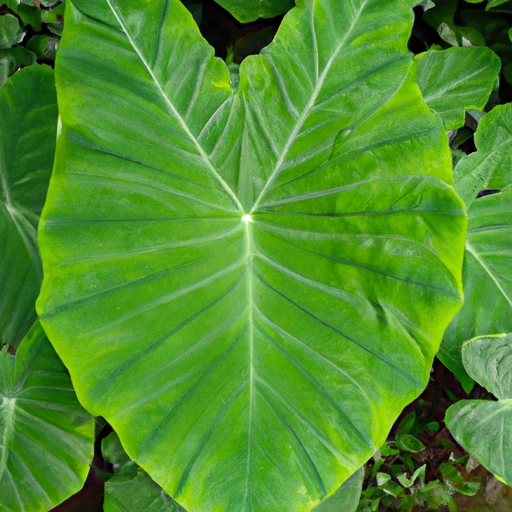Taro Leaf
Description

Taro leaf, known scientifically as Colocasia esculenta, is a heart-shaped leaf that comes from the taro plant. It is a staple ingredient in many Asian, African, and Pacific Island cuisines. Taro leaves are large and lush green in color, with a slightly ribbed texture. Often compared to spinach, taro leaves must be cooked before consumption to break down the calcium oxalate, which can be irritating when ingested raw.
Common uses
Taro leaves are commonly used in soups, stews, and curries. They can be used as a wrapping for meats and rice in dishes similar to dolmas or tamales. The leaves are also commonly made into a leafy green vegetable side dish, similar to spinach or collard greens.
Nutritional value
Calories
One cup (about 145 grams) of cooked taro leaves contains approximately 35 calories.
Protein
Each serving contains about 4 grams of protein, making it a good plant-based protein source.
Fat
Taro leaves are low in fat, with less than 1 gram per serving.
Carbohydrates
There are about 7 grams of carbohydrates per cup of cooked taro leaves.
Vitamins
The leaves are rich in vitamins A and C, essential for immune system health and vision.
Minerals
Taro leaves are a good source of minerals like calcium, potassium, and magnesium.
Health benefits
Taro leaves are beneficial for heart health due to their high potassium content, which can help control blood pressure. They're also high in fiber, which aids in digestion and helps maintain a healthy gut. The presence of vitamin C and other antioxidants helps to boost the immune system and combat free radicals.
Potential risks
Raw taro leaves contain calcium oxalate, which can be irritating to the mouth and digestive tract. It is crucial to cook the leaves thoroughly to neutralize this compound. People with kidney problems should also consume taro leaves with caution due to their high potassium content.
Common recipes
Popular recipes include Laing from the Philippines, where taro leaves are cooked in coconut milk, and the Hawaiian dish called luau, where they are steamed with meat and fish. In India, they're used in a spiced dish called patra.
Cooking methods
Taro leaves can be boiled, steamed, or sautéed. They should be cooked until tender, which usually takes about 10 to 15 minutes.
Pairing with other ingredients
They pair well with coconut milk, meats like pork and chicken, seafood, and spices such as ginger, garlic, and chili.
Summary
Taro leaf is a nutrient-rich, low-calorie leafy green with a variety of culinary uses. It must be cooked properly to avoid irritation from calcium oxalate. Taro leaves offer numerous health benefits, including being a good source of vitamins, minerals, and fiber. They feature in many traditional dishes around the world and can be a tasty addition to many recipes.